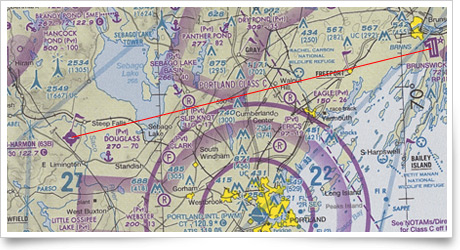Oct. 21, 2011, issue of 'AOPA ePilot: Flight Training Edition' newsletter
| ||||
| | FT News | INSIDE AOPA | TRAINING PRODUCTS | FINAL EXAM | |||
TRAINING TIPs Drilling down for details Consider the short 33-nautical-mile course discussed in the Oct. 14 “Training Tip: Check in, speak up.” As was noted, a pilot flying a course in Maine from Brunswick Executive Airport to Limington-Harmon Airport would be well advised to contact air traffic control before crossing north of the Class C airspace centered on the Portland International Jetport. Other noteworthy features of the airspace may or may not meet the eye during a casual review. One readily apparent item shows up soon after you depart Brunswick Executive. It’s a symbol on the sectional chart at Freeport, depicting a visual checkpoint just outside the Class C airspace. That’s a clue to stay alert for inbound traffic. Just beyond Freeport, before a set of railroad tracks, is a small national wildlife refuge. Check your altitude; pilots are requested not to overfly these areas below 2,000 feet above the surface. (The chart includes a summary of applicable regulations.) Note the profusion of seaplane bases and private airstrips in the area. One symbol for a private strip has the letter F, not the usual R, in the circle—why? (It is an ultralight flight park.) Obstructions are scattered along the route. If a pilot strayed west and north beyond the destination in marginal weather, obstacles as high as 2,549 feet msl could be encountered west of Sebago Lake. There may be more traffic out there than your chart suggests. If you plan your flight using the AOPA Internet Flight Planner, selecting the option to overlay terminal airspace fixes on the chart, several waypoints will appear. One, called JANOB, lies along your course line. What’s JANOB all about? Your instructor explains that JANOB serves as an initial fix for IFR aircraft flying the RNAV (GPS) approach to Portland’s Runway 18. They cross JANOB at 3,100 feet msl—worth knowing as you fly across the approach course. Waypoints may serve multiple purposes; JANOB also acts as a holding fix for other instrument approaches. Yes, the weather will be fair for your flight. But instrument pilots frequently practice in visual meteorological conditions. So keep your eyes and ears open for opposing traffic. Before you launch, a review of the Air Safety Institute’s Know Before You Go online course will provide a refresher on these and other airspace issues. YOUR PARTNER IN TRAININGHave you noticed more birds near or around your airport? Fall and spring are prime migratory seasons, and the possibility of a bird strike becomes all too real. Review the Air Safety Institute’s Bird Strike Safety Brief for important information on what to do in the air and on the ground if a bird strikes your airplane.
Did you know that student pilots who join AOPA are three times more likely to complete their flight training? Membership includes unlimited access to aviation information by phone (800/USA-AOPA, weekdays from 8:30 a.m. to 6 p.m. Eastern time) or from Flight Training Online or AOPA Online. If you're not already a member, join today and get the pilot’s edge. Login information is available online. FLIGHT TRAINING NEWSATP purchases 30 SeminolesAirline Transport Professionals (ATP) has agreed to purchase 30 Piper Seminoles, the company announced at the National Business Aviation Association show in Las Vegas. ATP will take delivery of 10 airplanes this year with options for 20 more to be delivered in 2012 and 2013. Read more >> US Aviation Academy gets military contractUS Aviation Academy in Denton, Texas, has secured a $11.7 million contract from the U.S. Air Force to train foreign military flight training cadets. Under the agreement, US Aviation Academy will screen the cadets for advanced Air Force training. They will undergo 25 hours of flight time and 30 days of ground school, flying in Cessna 172s and Diamond DA40s. The objective is to get them to solo. The first four cadets will arrive in October from Nigeria. ‘Women Airborne’ takes 210 aloft in CanadaPilots at Lyncrest Airport near Winnipeg, Manitoba, took 210 women and girls on flights on Sept. 10. The passengers ranged in age from 2 years old to 86. The pilots believe they now hold the record for greatest number of females flown at the same airport on the same day. Read more >> Thinking about flying in the mountains?Flying around mountainous terrain should not be taken lightly, and it’s a skill best learned under the guidance of an experienced instructor. Your airplane is flying close to its performance limitations, and your preflight planning—not to mention stick-and-rudder skills—must be sharp. Truly understanding density altitude, mountain wave airflow, and what your airplane is capable of can make you a better pilot regardless of where you fly. With the Air Safety Institute’s Mountain Flying online course, you’ll learn what skills you need to know before venturing into the high country. But they are skills that will serve you well everywhere! ‘Miracle’ pilot, passenger earn seaplane ratingsAfter a river landing that made news around the world in 2009, two pilots got their official sanction to take off and land on water. Jeff Skiles, first officer of US Airways Flight 1549, and Clay Presley, a passenger on the Airbus that made an emergency landing on the Hudson River, earned their seaplane ratings earlier this month in Wisconsin. Presley, who learned to fly in part because of the 2009 incident, became a private pilot in June. Skiles’ experience must have paid off; his instructor said he accomplished the training in about half the time it takes most pilots, according to the Ozaukee Press. Inside AOPANo tower? No problem!The word “airport” usually evokes an image of a control tower perched somewhere near a runway. Actually there are more airports without a control tower than with one. But, whether you fly at a nontowered airport or soon plan to enter the traffic pattern at one, take a good look at the Air Safety Institute’s Operations at Nontowered Airports to review some critical dos and don’ts. From communications tips to procedural guidance, you’ll feel better equipped to participate safely with other traffic in and around the pattern. Download the Safety Advisor >> Hertz announces ‘Working for the Weekend’ giveawayEnter today for a chance to win a new car or a free weekend rental. You could win your choice of a new 2011 Dodge Challenger RT, Chrysler 200 Convertible, or Jeep Wrangler. Plus, you can play instantly to win the free weekend day. Visit the website for more details and to enter for your chance to win. Surprising benefits of AOPA credit cardYou've been hearing about AOPA's credit card for years, and you may have thought you don’t need another credit card. Sure, your use of this card earns you points quickly (one point for each dollar spent) that you can redeem for cash and merchandise. Sure, your use of this card helps AOPA and its advocacy efforts on behalf of all general aviation pilots. But there are other surprising benefits of using the card. Read more >> TRAINING PRODUCTSChart markers from Pilotmall.comWorking on flight planning? Keep sectional charts in good shape with erasable markers that let you draw routes and then remove them. Chart markers come in a package of two (fluorescent yellow and pink) for $2.89. Order online from Pilotmall.com. Note: Products listed have not been evaluated by ePilot editors unless otherwise noted. AOPA assumes no responsibility for products or services listed or for claims or actions by manufacturers or vendors. FINAL EXAMQuestion: Can a student pilot fly a high-performance airplane during his or her training for a private pilot certificate?
Answer: Yes, a student pilot may fly a high-performance airplane while training for the private pilot certificate. If you choose to use a high-performance airplane your flight instructor will need to provide you with the necessary training specific to high-performance operations and endorse your logbook. When you have the endorsement you will be legal to fly solo as long as your student pilot certificate has all the proper endorsements. Keep in mind that building hours in a high-performance airplane can make it easier to get owners or renters insurance. For more insight, review the Air Safety Institute’s aircraft-specific Safety Highlights.
Got a question for our technical services staff? Email [email protected] or call the Pilot Information Center, 800/872-2672. Don’t forget the online archive of “Final Exam” questions and answers, searchable by keyword or topic. WHAT’S NEW ONLINEThe late Steve Jobs imparted some wisdom that applies to student pilots, even though he was talking about himself at the time. Flight Training Deputy Editor Ian J. Twombly explains the connection in the latest Flight Training blog. AOPA Career OpportunitiesEver dream of turning your passion for aviation into a career? We’re looking for a director of media relations, Web business analyst, donor relations specialist, medical certification assistant, associate editor–Web, associate editor–Web/ ePilot, production assistant–Web, .Net developer, aviation technical specialist, and manager of airspace and modernization. To learn more about other AOPA career opportunities, visit AOPA Online. Picture Perfect AVIATION EVENTS & WEATHER To include an event or to search all events in the calendar, visit AOPA Online. For airport details, including FBO fuel prices, see AOPA Airports. Flight Instructor Refresher ClinicsThe next Air Safety Institute Flight Instructor Refresher Clinics are scheduled in Corpus Christi, Texas, Oct. 29 and 30; Atlanta, Ga., Nov. 5 and 6; Anchorage, Alaska, San Diego, Calif., and Ashburn, Va., Nov. 12 and 13; Albuquerque, N.M., and Austin, Texas, Nov. 19 and 20; and Denver, Colo., Orlando, Fla., and Northbrook, Ill., Dec. 3 and 4. For a complete schedule, see AOPA Online.
Can’t make it in person? Sign up for the CFI Refresher Online. Air Safety Institute Safety SeminarsAir Safety Institute Safety Seminars are scheduled in Concord, Calif., and Chesterfield, Mo., Oct. 24; Springfield, Mo., and Lynchburg, Va., Oct. 25; Warrensburg, Mo., Oct. 26; Pensacola, Fla., Greenville, S.C., and Salt Lake City, Utah, Nov. 1; Birmingham, Ala., Atlanta, Ga., and Boise, Idaho, Nov. 2; Hunstville, Ala., Marietta, Ga., and Pocatello, Idaho, Nov. 3; and Pikeville, N.C., Nov. 5.
Topics vary—for details and a complete schedule, see AOPA Online. | Advertisers Got news? Contact ePilot. Having difficulty using this service? Visit the ePilot Frequently Asked Questions now at AOPA Online or write to [email protected]. |
| This issue of ePilot was created for &fname; &lname; at &*TO; Member Tools : Send feedback | ePilot Archive Editorial Team: ePilot Flight Training Editor : Jill W. Tallman | ePilot Editor: Sarah Brown | Contributor: Alton K. Marsh |





